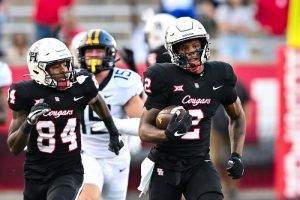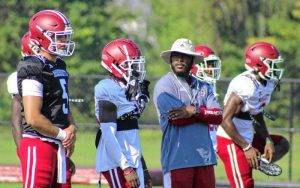Football, often hailed as a thrilling spectacle of strategy and athleticism, unfolds on the gridiron where various positions collaborate to orchestrate plays and score points. Among the key contributors to offensive prowess are Wide Receivers (WRs). In this in-depth exploration, we aim to decode the meaning of WR in football, shedding light on the crucial role these players play in the game. From understanding their responsibilities and strategic importance to delving into iconic moments and the evolution of the position, this comprehensive guide unfolds the intricate narrative of Wide Receivers in the world of football.
Understanding the Essence: What Does WR Mean in Football?
Positional Dynamics:
In football terminology, WR stands for Wide Receiver, a position integral to the offensive lineup. Wide receivers line up on the periphery of the offensive formation, flanking the offensive line. They are typically positioned wide on the field, closer to the sidelines, hence the term “wide” receivers.
Diverse Roles:
The term WR encompasses a diverse array of player roles, each contributing uniquely to the offensive strategy. From speedsters who stretch the field vertically to possession receivers known for reliable hands, the WR position accommodates a spectrum of playing styles.
Key Responsibilities:
Wide receivers have multifaceted responsibilities during a game. Their primary objective is to catch passes thrown by the quarterback, advancing the ball down the field. Additionally, they play a crucial role in blocking, aiding ball carriers, and executing route running with precision.
Evolution of Wide Receivers: From Flashy Flankers to Strategic Playmakers
Historical Perspectives:
The role of wide receivers has evolved significantly over the decades. In the early days of football, receivers were often referred to as “ends” and played close to the offensive line. As the passing game gained prominence, the position expanded, giving rise to dedicated wide receivers.
Speed and Agility Emphasis:
With the evolution of the passing-centric game, the emphasis on speed and agility became paramount for wide receivers. Teams sought players with the ability to outrun defenders, create separation, and make explosive plays downfield.
Strategic Diversification:
Modern football witnesses a strategic diversification of the wide receiver position. Teams deploy a mix of wideouts with distinct skill sets—some excel at deep routes, while others thrive in short and intermediate patterns. This strategic diversity keeps opposing defenses on their toes.
Crucial Attributes: The Arsenal of a Wide Receiver
Speed and Acceleration:
One of the defining attributes of a successful wide receiver is speed. The ability to quickly accelerate off the line of scrimmage, outrun defenders, and create separation is instrumental in making big plays in the passing game.
Agility and Route Running:
Agility and precise route running are cornerstones of effective wide receiver play. A receiver’s ability to make sharp cuts, change direction swiftly, and run crisp routes enables them to outmaneuver defenders and get open for passes.
Hands and Catching Ability:
Possessing reliable hands and exceptional catching ability are non-negotiables for wide receivers. Whether making contested catches in traffic or securing routine passes, a receiver’s hands are their primary tools for ball control.
Physicality and Yards After Catch (YAC):
The physicality of wide receivers comes into play when contending with defenders for contested catches. Additionally, the capability to gain yards after making a catch (YAC) adds significant value, turning short receptions into substantial gains.
Strategic Significance: Wide Receivers as Offensive Catalysts
Vertical Stretch:
Wide receivers contribute to the vertical stretch of the field, forcing defenses to cover the entire width and depth. Speedy deep threats draw defenders away from the line of scrimmage, creating opportunities for intermediate and short passes.
Red Zone Targets:
In the red zone, where the field tightens, tall and physical wide receivers become valuable targets. Their ability to make contested catches in the end zone can be a game-changer, providing the offense with a reliable scoring option.
Explosive Plays and Big Moments:
Wide receivers are often the protagonists in explosive plays and pivotal moments. Whether it’s a deep touchdown reception, a game-winning catch, or a critical third-down conversion, wide receivers emerge as playmakers in high-stakes situations.
Iconic Moments: Wide Receivers Etching Their Names in Football Lore
The Catch by Dwight Clark:
Dwight Clark’s iconic catch in the 1981 NFC Championship Game, famously known as “The Catch,” is etched in football history. The connection between Clark and quarterback Joe Montana showcased the impact a wide receiver can have in the most crucial moments.
Randy Moss’s Record-Breaking Season:
Randy Moss’s record-breaking 2007 season with the New England Patriots exemplified the dominance a wide receiver can exert. Moss set the single-season touchdown reception record, leaving an indelible mark on the league.
Odell Beckham Jr.’s One-Handed Grab:
Odell Beckham Jr.’s spectacular one-handed catch in 2014 transcended the realm of sports highlights. The acrobatic reception showcased the athleticism and jaw-dropping skills that make wide receivers the darlings of football fans.
Strategies for Success: Training and Preparation for Wide Receivers
Speed and Agility Training:
Wide receivers engage in specialized training regimens focused on enhancing speed and agility. Cone drills, ladder drills, and sprinting exercises contribute to the development of explosive movements on the field.
Route Running Drills:
Precision in route running is honed through meticulous drills. Wide receivers practice running a variety of routes, perfecting the timing and execution required to get open and receive passes from the quarterback.
Catching Drills:
Catching drills form a fundamental part of a wide receiver’s practice routine. Whether it’s tracking balls in the air, making contested catches with defenders in coverage, or refining hand-eye coordination, catching drills are paramount.
Film Study:
In-depth film study is a key component of a wide receiver’s preparation. Analyzing opposing defenses, understanding coverage schemes, and studying the tendencies of defenders contribute to strategic insights that can be exploited during games.
The Impact of Wide Receivers Off the Field: Branding and Endorsements
Personal Branding:
Successful wide receivers often leverage their on-field success to build personal brands. From cultivating a strong social media presence to engaging with fans, personal branding enhances a player’s marketability and visibility beyond the football field.
Endorsements and Sponsorships:
Wide receivers, especially those with star power, attract endorsements and sponsorships from prominent brands. Apparel deals, commercials, and partnerships contribute to the off-field income of successful wide receivers.
Community Engagement:
Many wide receivers actively engage with their communities, participating in charitable initiatives and community service. Beyond the game, their impact extends to making a positive difference in society.
Challenges and Realities: Overcoming Adversities in the NFL
Injuries and Physical Toll:
The physically demanding nature of football, coupled with the high-impact plays wide receivers are involved in, makes injuries a persistent challenge. Overcoming injuries and managing the physical toll is a testament to a player’s resilience.
Defensive Adjustments:
Successful wide receivers often face heightened defensive attention, including double coverage and strategic adjustments by opposing teams. Adapting to these defensive schemes requires tactical acumen and versatility.
Team Dynamics and Quarterback Chemistry:
Wide receivers must establish strong chemistry with their quarterbacks to maximize their effectiveness. Adjusting to different quarterback styles, understanding play-calling nuances, and building rapport are essential elements of successful team dynamics.
The Future of Wide Receivers: Trends and Innovations
Technological Integration:
Advancements in sports technology, including wearable devices and analytics, play a role in shaping the training and performance evaluation of wide receivers. Data-driven insights contribute to personalized training programs and strategic decision-making.
Positional Specialization:
The future may witness increased specialization within the wide receiver position. Teams could deploy players with specific skill sets tailored to exploit particular aspects of opposing defenses, contributing to a more nuanced and strategic approach.
Globalization of the NFL:
As the NFL continues to expand its global footprint, wide receivers from diverse backgrounds may bring unique playing styles and cultural influences to the position. The globalization of the league could lead to a richer tapestry of wide receiver talent.
Related Post:
The Grand Stage of Golf: Unveiling the Majesty of the Biggest Golf Tournament
Navigating the Diamond: Exploring the Strategic Dynamics of Softball Positions
Understanding the Duration of Rugby Games: A Comprehensive Guide
In the grand symphony of football, wide receivers compose a melody of speed, skill, and strategic brilliance. From their inception as ends close to the offensive line to their evolution into dynamic playmakers, wide receivers have become central figures in the narrative of the game. As they sprint down the sidelines, make acrobatic catches, and celebrate in the end zone, wide receivers embody the essence of football’s exhilarating spirit.
The meaning of WR in football extends beyond the positional designation; it encapsulates a legacy of iconic moments, strategic evolution, and the enduring pursuit of excellence. So, as the next generation of wide receivers takes the field, the world eagerly anticipates the next verse in the ever-evolving symphony of these dynamic and indispensable players. Whether it’s a game-winning catch in the Super Bowl or a highlight-reel play that echoes through generations, the wide receiver position continues to captivate audiences and etch its mark on the storied tapestry of football history.



